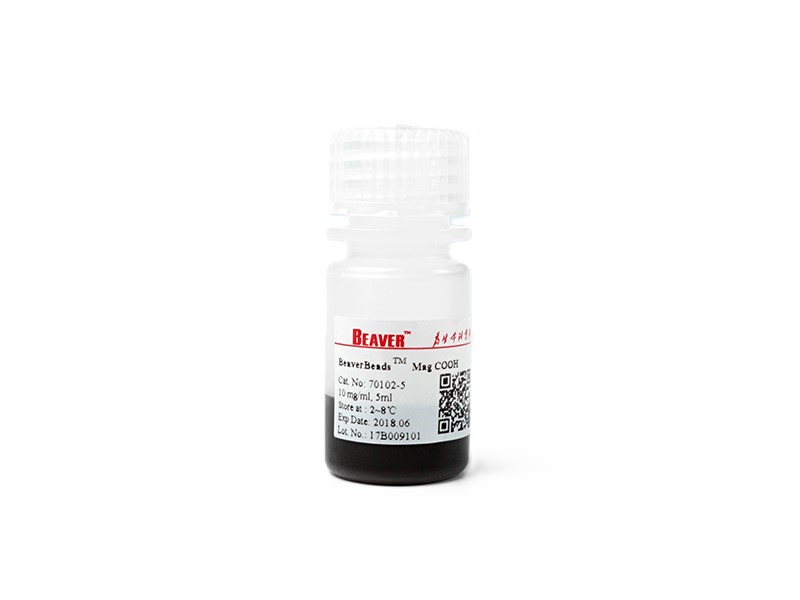- Home
- IVD
- By Technology Types
- By Diseases Types
- By Product Types
- Research
- Resource
- Distributors
- Company

| Product Name | Mag COOH-3 µm |
| Catalog No. | SM-HMM-0017 |
| Description | Polymer-coated magnetic beads have rich functional COOH or NH2 groups, which are capable of covalently immobilizing biological ligands, such as peptides, proteins, antibodies and oligonucleotides. These magnetic beads can be used for immunology detection and molecular biology research. |
| Features | Abundant binding sites to enhance specific binding to ligands. Superparamagnetism and high magnetic responsiveness, saving operation time. Good dispersibility and resuspension, improving the convenience of operation. Good physicochemical stability to guarantee reproducible results. |
| Storage | Stable at 2-8°C (can be stored or transported at room temperature for short periods of time) |
| Shelf Life | 2 years |
| Average Particle Size | 3 µm |
| Surface Group / Content | COOH (~100 µmol/g) |
| Magnetic Core | Fe3O4 |
| Shell | Polymer |
| Magnetism Type | Superparamagnetic |
| Preservation Fluid | Sterile water, 0.05% (V/V) proclin-300 |
| Concentration | 10 mg/mL |
Magnetic beads have become indispensable tools in modern scientific research, revolutionizing processes in molecular biology, immunology, and related fields. Their unique combination of magnetic responsiveness and functional surface chemistry enables efficient separation, purification, and detection of biological targets, addressing key challenges such as low sample concentration, complex matrices, and time-consuming workflows.
In the realm of research-grade magnetic beads, carboxyl (COOH)-functionalized variants stand out for their versatility and reliability. These beads leverage the reactivity of COOH groups to form stable covalent bonds with primary amines (-NH2) on biological ligands—including antibodies, proteins, peptides, and oligonucleotides—through well-established coupling reactions (e.g., EDC/NHS activation). This covalent immobilization ensures minimal ligand leaching, enhances binding specificity, and supports consistent performance across multiple experimental cycles.
Mag COOH-3 µm is engineered specifically for research applications, filling a critical niche for scientists seeking a balance between particle size, binding capacity, and operational efficiency. Unlike larger beads that may settle rapidly or smaller beads that require prolonged magnetic separation, the 3 µm average particle size offers an optimal compromise: it provides sufficient surface area for high ligand loading while maintaining fast magnetic responsiveness. This makes the product ideal for a wide range of research scenarios, such as:
Immunoprecipitation (IP) and co-immunoprecipitation (Co-IP) to isolate protein complexes
Nucleic acid purification (DNA/RNA extraction) from cell lysates, tissues, or biological fluids
Enzyme-linked immunosorbent assays (ELISA) and magnetic bead-based immunoassays
Biomolecule conjugation studies and affinity chromatography
Cell sorting and enrichment for downstream molecular analysis
As research demands evolve—with a growing focus on high-throughput screening, miniaturized experiments, and reproducible results—Mag COOH-3 µm is designed to meet the rigorous standards of academic laboratories, biotech research teams, and pharmaceutical R&D departments. Its polymer-coated Fe3O4 core ensures biocompatibility, preventing non-specific binding to biological samples and safeguarding the integrity of target molecules throughout experimental workflows.
Abundant carboxyl functional groups (~100 µmol/g) distributed uniformly across the polymer shell, maximizing ligand immobilization capacity and ensuring strong binding affinity with biological targets.
Superparamagnetic property that enables rapid separation under an external magnetic field, eliminating the need for centrifugation or filtration and significantly reducing operation time.
Excellent dispersibility in aqueous solutions, avoiding aggregation and ensuring homogeneous interaction with samples for consistent and reliable experimental outcomes.
Easy resuspension with minimal vortexing or pipetting, enhancing operational convenience and reducing the risk of sample loss during handling.
Robust physicochemical stability, maintaining structural integrity and functional activity across a wide range of pH values (3.0–10.0), temperatures (2–37°C), and common buffer systems (PBS, Tris-HCl, HEPES).
Sterile formulation with 0.05% (V/V) proclin-300 as a preservative, preventing microbial contamination and extending shelf life to 2 years when stored at 2–8°C.
Precise average particle size (3 µm) with narrow size distribution, ensuring uniform performance across all beads and minimizing variability between experiments.
Biocompatible polymer shell that reduces non-specific binding to proteins, cells, or nucleic acids, improving the signal-to-noise ratio in detection and purification assays.
Superior binding efficiency: The high density of COOH groups enables maximum ligand loading, resulting in enhanced capture of target biomolecules even from low-concentration samples.
Time-saving workflow: Fast magnetic responsiveness allows for quick separation (typically 30–60 seconds per step), accelerating experiments and increasing throughput for high-volume research projects.
Consistent reproducibility: Stable physicochemical properties and tight quality control ensure that results are consistent across batches, reducing experimental variability and supporting publication-quality data.
User-friendly operation: Excellent dispersibility and resuspension characteristics simplify handling, making the product suitable for both experienced researchers and laboratory technicians new to magnetic bead-based methods.
Versatile application scope: Compatible with a wide range of biological ligands and experimental protocols, eliminating the need for multiple specialized beads and streamlining laboratory inventory.
Cost-effective performance: High binding capacity and reusable potential (when applicable) reduce the amount of beads required per experiment, lowering overall research costs without compromising quality.
Safe and reliable: Non-toxic Fe3O4 core and sterile formulation ensure compatibility with biological samples and compliance with research safety standards.
For research use only, not for clinical use.
|
There is no product in your cart. |